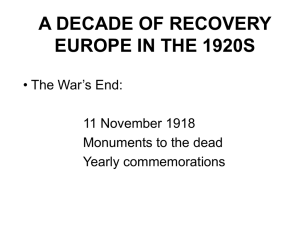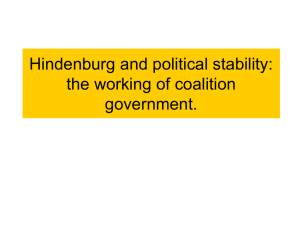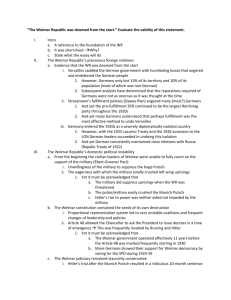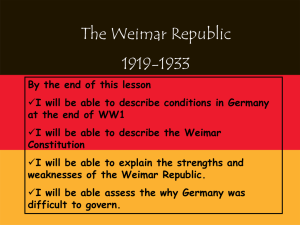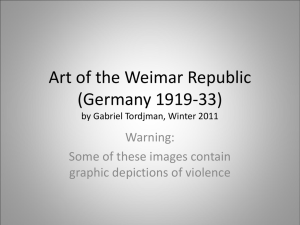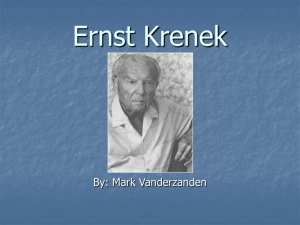WR Revision Handout 2
advertisement
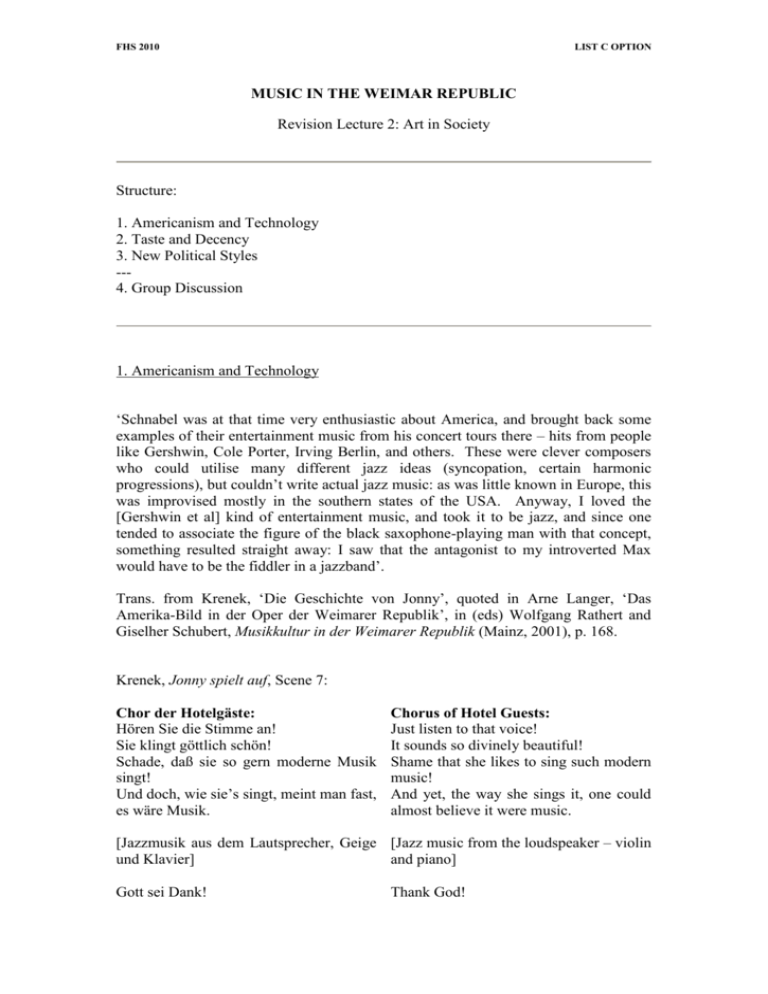
FHS 2010 LIST C OPTION MUSIC IN THE WEIMAR REPUBLIC Revision Lecture 2: Art in Society Structure: 1. Americanism and Technology 2. Taste and Decency 3. New Political Styles --4. Group Discussion 1. Americanism and Technology ‘Schnabel was at that time very enthusiastic about America, and brought back some examples of their entertainment music from his concert tours there – hits from people like Gershwin, Cole Porter, Irving Berlin, and others. These were clever composers who could utilise many different jazz ideas (syncopation, certain harmonic progressions), but couldn’t write actual jazz music: as was little known in Europe, this was improvised mostly in the southern states of the USA. Anyway, I loved the [Gershwin et al] kind of entertainment music, and took it to be jazz, and since one tended to associate the figure of the black saxophone-playing man with that concept, something resulted straight away: I saw that the antagonist to my introverted Max would have to be the fiddler in a jazzband’. Trans. from Krenek, ‘Die Geschichte von Jonny’, quoted in Arne Langer, ‘Das Amerika-Bild in der Oper der Weimarer Republik’, in (eds) Wolfgang Rathert and Giselher Schubert, Musikkultur in der Weimarer Republik (Mainz, 2001), p. 168. Krenek, Jonny spielt auf, Scene 7: Chor der Hotelgäste: Hören Sie die Stimme an! Sie klingt göttlich schön! Schade, daß sie so gern moderne Musik singt! Und doch, wie sie’s singt, meint man fast, es wäre Musik. Chorus of Hotel Guests: Just listen to that voice! It sounds so divinely beautiful! Shame that she likes to sing such modern music! And yet, the way she sings it, one could almost believe it were music. [Jazzmusik aus dem Lautsprecher, Geige [Jazz music from the loudspeaker – violin und Klavier] and piano] Gott sei Dank! Thank God! FHS 2010 LIST C OPTION [Sie geraten auf ihren Stühlen in rhythmische Bewegungen, ohne zunächst eigentlich zu tanzen. Später fangen manche von den Gästen an, auf der Terrasse zu tanzen. Jubelnd.] [They move around rhythmically on their chairs, without actually starting to dance. Shortly, many of them start to dance on the terrace. Jubilation.] Das ist Jonnys Jazzband! That’s Jonny’s Jazz Band! Key issues: America as model for German reconstruction; images of the metropolis; authenticity of ‘jazz’ styles; advantages and disadvantages of radio broadcasting; ‘funkeigene [radio-specific] Musik’ Key works: Krenek, Jonny spielt auf (1927) Franz Schreker, Kleine Suite für Orchester (1928) Bibliography: Susan C. Cook, ‘Jazz: The Sound of the New World’, in Opera for a New Republic: The Zeitopern of Krenek, Weill, and Hindemith (Michigan, 1988), pp. 41-75 Cook, ‘Ernst Krenek: Jonny spielt auf’, in Opera for a New Republic, pp. 77-114 Christopher Hailey, ‘Rethinking Sound: Music and Radio in Weimar Germany’, in Music and Performance during the Weimar Republic (Cambridge, 1994), pp. 13-36 J. Bradford Robinson, ‘Jazz Reception in Weimar Germany: In Search of a Shimmy Figure’, in Bryan Gilliam (ed.), Music and Performance during the Weimar Republic (Cambridge, 1994), pp. 107-134 2. (Inter)marital relations Key issues: shifting of gender roles (‘emanzipierte Frau’?); disruption of marriage; reconsideration of love; emphasis moves from soul to body, eternity to entertainment; tolerance of sexual difference Key works: Hindemith, Neues vom Tage (1929) Bibliography: Cook, ‘Paul Hindemith: Neues vom Tage’, in Opera for a New Republic, pp. 147-71 Walter Laqueur, ‘Berlin s’amuse’, in Weimar: A Cultural History (New York, 1974) pp. 224-53 FHS 2010 LIST C OPTION 3. New Political Styles Key issues: foundation of KPD (‘Kommunistische Partei Deutschlands’) and NSDAP (‘Nationalsozialistische Arbeiterpartei’); aggressive approaches to culture of both; forcing out of the former by the latter Bibliography: Eberhard Kolb, ‘Origin and consolidation of the Republic’ and ‘The rise of National Socialism in the shadow of the world economic crisis’, in The Weimar Republic (2nd edn, London, 2005), pp. 3-52 and 101-115 FHS 2010 LIST C OPTION 4. Group Discussion Americanism and Technology How might the spread of radio technology have aided and informed the ideals of Neue Sachlichkeit? (Inter)marital relations In what senses is Hindemith and Schiffer’s Neues vom Tage a good example of Zeitoper? New Political Styles How accurate is it to speak of a Communist and Fascist (or National Socialist) music in the 1920s and early 1930s?

